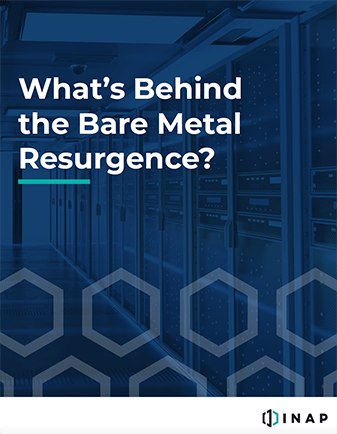Month: March 2023

Security Challenges Have Tech Execs Second-Guessing the Cloud
Keep bad actors out. Teach good cyber hygiene. Monitor for anomalies. Detect attacks faster. Improve response times & techniques. And do it all with fewer resources and smaller budgets. Today’s tech execs certainly have their work cut out for them!
It seems the cyber security “to-do” list gets longer every minute and for many, migrating to the cloud adds even more line items.
The truth is – you could adhere to every security protocol on the planet, but if the other tenants in your shared environment don’t have the same level of stringency, your organization is still at risk.
What’s more, public cloud providers may have a portfolio of readily accessible and up-to-date tools for businesses to secure their data in the cloud, including compliance services for security-focused verticals like healthcare, finance and government. But they still get hacked.
So what’s an IT leader to do? Bring things back in-house, hire new talent, buy more equipment and lose out on all the capabilities the cloud provides? Not likely.
Many say it’s time to reconsider Bare Metal servers because they can deliver privacy and security without sacrificing performance.
You control the level of security. A bare metal server is dedicated to your business, so you don’t have to worry about someone else’s lackadaisical security practices putting your organization at risk.
You configure the servers the way you want. You can configure bare metal servers to meet your business’s exact requirements. And root access makes it easy to upgrade, add resources and scale on demand.
You determine performance. You can pick and choose what applications to install to ensure you have the most disk, memory and processing power available and get the most capacity possible.
Bonus: You never have to worry about “surprise” cloud costs. Bare metal servers are affordable because their costs are predictable. You pay the same monthly fee for the time used. Period.
Bare metal servers can help you check off items on your cybersecurity list, deliver performance and reduce costs, but that’s just the beginning. The more you look into them, the more benefits you’ll discover.
Want to learn more about the Bare Metal Resurgence?
Explore HorizonIQ
Bare Metal
LEARN MORE
Stay Connected

Two Important Reasons Not to Migrate to the Cloud
Today, it seems like everyone has an opinion on how moving data and workloads to public cloud services is a good idea. What’s not often discussed is why, in some cases, public cloud isn’t a good fit.
Don’t get me wrong. The public cloud provides numerous benefits, and it makes sense for many organizations – but not all. For companies with applications that require optimal performance, variability and limitations of public cloud can be disruptive.
Here are two of the biggest reasons IT leaders are questioning if public cloud is right for their mission-critical applications.
Reason #1: Performance is a crapshoot. You never know what you’re going to get.
Whether your data and processes run on dedicated infrastructure or are distributed across virtual machines, the underlying physical servers limit the resulting performance. What’s running on them? Who else is taxing their resources? How are they being accessed?
Public cloud computing requires the use of a management and orchestration layer of applications to operate and distribute the workload. This overhead requires server resources to operate, eating-up capacity and creating variability in performance as some processes may be distributed across multiple data centers over time.
Additionally, performance-sensitive applications struggle in multi-tenant environments, where “noisy neighbors” can pop up unexpectedly and monopolize bandwidth, disk I/O, CPU and other resources.
Finally, while you can purchase cloud-connect links to reach the public cloud and avoid best-efforts internet, connectivity within the distributed hyperscale infrastructure is a big “black box” which creates the potential for lag, performance impairments and in extreme situations, outages.
Reason #2: The public cloud holds the cards, so they make all the decisions.
Enterprises have little say after workloads are migrated to the cloud. Providers own, manage and monitor the entire cloud infrastructure.
Organizations don’t know where their data is operating, let alone who else shares their server. And when there’s an issue, the cloud provider decides how to fix it and when.
There’s also little room for customization. Most public cloud providers offer fixed options and terms that may not align with what the organization really needs.
Today’s CIOs and CTOs are turning to Bare Metal servers for true real-time performance and endless customization options.
A bare metal server is 100% dedicated to the business. Organizations never share storage, connection or bandwidth – which ensures maximum performance and eliminates the “noisy neighbor” effect.
Bare metal servers also allow for higher resource utilization. Enterprises don’t have to worry about multi-tenanting overhead or a base operating system hogging disk, memory and processing power.
Enterprises can configure bare metal servers to meet the exact needs of the business. And since the owner has root access to the server, it’s easy to upgrade, add resources and scale on demand.
Put your workloads where they make the most sense.
Organizations that need to improve agility and want to keep their IT team focused on business generating efforts may want to migrate workloads to the cloud. However, bare metal presents a straightforward and convenient option for organizations that need predictable and constant access to resources.
Explore HorizonIQ
Bare Metal
LEARN MORE
Stay Connected

CIOs and CFOs at Odds Over Cloud Costs – Here’s a Win-Win
CIOs are under pressure to accelerate digital transformation. CFOs are under pressure to reduce wasteful spending. And economic turmoil combined with unpredictable cloud costs are taking the priority tug-of-war to a whole new level.
Public cloud comes with a lengthy list of benefits – agility and flexibility, secure data storage, better application performance, staff optimization and the ability to leverage new technologies. But these convenient capabilities all come at a premium.
Beyond billing for unused resources, businesses often end-up paying public cloud providers for the same data multiple times (storage, transfer and compute), making them, bit for bit, the most expensive option available. What’s more, their usage-based models mean that the costs can vary drastically from month to month, making expenses unpredictable.
On-premises infrastructure is no better; cloud migration continues for good reason. Connectivity options are limited which exposes your data and applications to unexpected interruptions. Purchasing servers and other hardware requires a significant amount of upfront capital. There are also ongoing OpEx required to manage, monitor and maintain on-premises infrastructure to consider. Continuously buying new hardware, software and licenses adds up over time.
This conundrum has IT leaders feeling like they must choose between the lesser of two evils – and continue butting heads with CFOs in the process. However, there is a third option.
Consider Bare Metal Servers
When you get down to brass tacks, bare metal servers are surprisingly affordable and come with highly predictable monthly costs. They also deliver the capabilities today’s organizations require – performance, security and control.
Think about it.
A Bare Metal server is 100% dedicated to the business and designed to maximize capacity. There are no “noisy neighbors” competing for bandwidth, disk I/O, CPU and other resources.
Another plus: they’re secure and private because they’re single-tenant platforms, which is especially crucial for highly regulated industries like healthcare, FinServ and government.
Bare metal servers are also a blank slate. Businesses can configure them however they want. And with the ability to upgrade quickly and easily, organizations can stay nimble.
Arguably the best part about bare metal servers is that contracts are straightforward and flexible by default. Companies pay a set fee for the time used, and that’s it.
So the next time you’re feeling stuck between a rock and a hard place when it comes to advancing your digital initiatives and cutting costs, think about bare metal servers. They may just be the right solution for you (and your CFO).
Want to learn more about the Bare Metal Resurgence?




